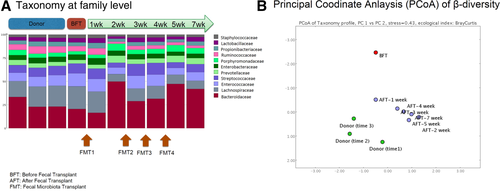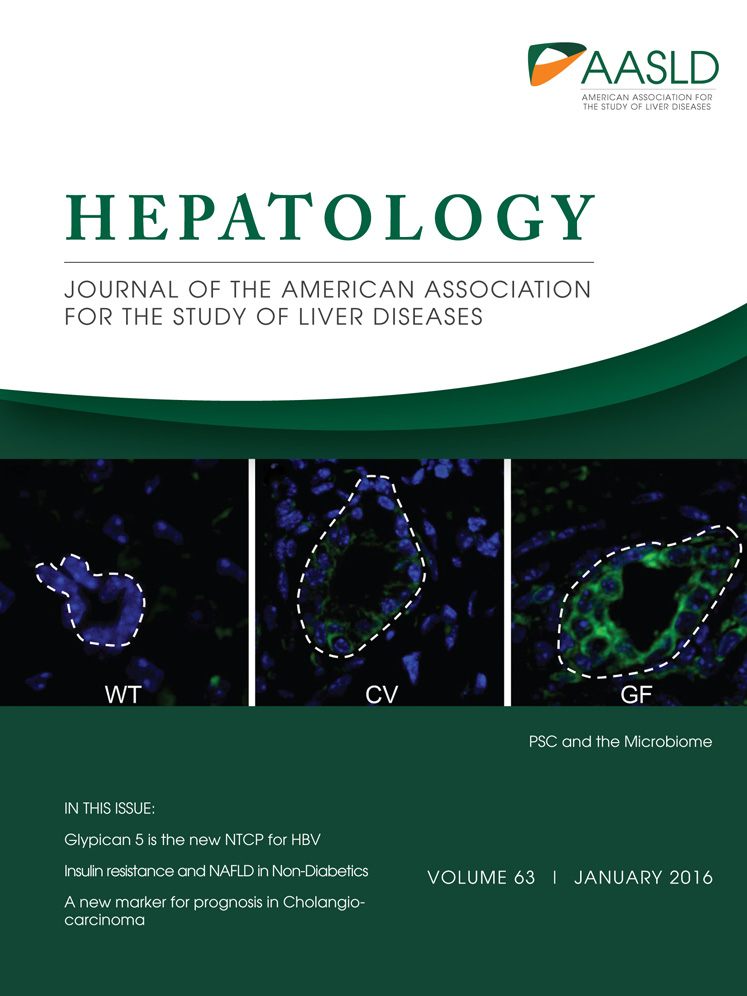Fecal microbiota transplantation in the management of hepatic encephalopathy
Potential conflict of interest: Nothing to report.
Supported by the University of Alberta Hospital Foundation.
Abbreviations
-
- FMT
-
- fecal microbiota transplantation
-
- HE
-
- hepatic encephalopathy
-
- ICT
-
- inhibitory control test
Hepatic encephalopathy (HE) is a common and debilitating complication of end-stage liver cirrhosis. It is associated with poor quality of life, a significant burden on health care, and increased mortality. Ammonia generated by the enteric bacteria is a critical driver of HE.1 The current treatment is lactulose and/or rifaximin, both of which target the gut microbiota.2, 3 As dysbiosis is thought to contribute to HE, we hypothesized that manipulating the gut microbiome through fecal microbiota transplantation (FMT) could reverse intestinal dysbiosis and result in cognitive improvement in overt HE. Health Canada approval was obtained to proceed with the study.
Case Report
We treated a 57-year-old man suffering from grade 1-2 HE with liver cirrhosis (Model for End-Stage Liver Disease score = 10) secondary to alcohol and hepatitis C. He had previously responded well to lactulose and rifaximin but could no longer afford rifaximin when Health Canada ended its compassionate release program. His subjective baseline assessment by his caregivers and health care team found him lethargic, with sleep-wake cycle reversal, slow reaction time, and intermittent disorientation for time. After obtaining informed consent, he was given five weekly FMTs from a universal stool donor registered with our FMT program, the first administered by colonoscopy and the remaining four by retention enema. Subjective and objective changes in mental status were assessed weekly, including use of the inhibitory control test (ICT) and the Stroop test. Random serum ammonia levels were measured at each visit. The patient was instructed to keep his diet and lactulose dose similar during the study. Within the first week of treatment, objective measures of reaction time, Stoop test, serum ammonia, and quality of life all significantly improved. Subjectively the patient reported improved appetite, alertness, and overall well-being. Unfortunately, he missed his second FMT, and these parameters deteriorated. Following further FMT, he continued to improve as he became more alert, with better ability to concentrate and follow instructions and improved sleep–wake cycle. All of these changes were noted by the study team and corroborated by his caregivers. Objectively, his ICT and Stroop test scores normalized by week 4. The patient unfortunately developed gallstone pancreatitis and required hospitalization for pain control at week 10, when he was noticeably more encephalopathic. By week 14, his ICT and Stroop scores had reverted to baseline. Table 1 summarizes the changes in ICT, Stroop test, and random serum ammonia levels in relation to FMT. No adverse events or infectious complications related to FMT occurred.
| 1 week | 2 weeks | 3 weeks | 4 weeks | 7 weeks | 10 weeks | 14 weeks | ||
|---|---|---|---|---|---|---|---|---|
| Before FMT | FMT 1 (by colonoscopy) ↓ | FMT 2 (by enema) ↓ | FMT 3 (by enema) ↓ | FMT 4 (by enema) ↓ | ||||
| ICT (lures) (normal <5) | 17 | 19 | a | 15 | 5 | 8 | b | 17 |
| Stroop test (seconds) (normal <200 seconds) | 250.9 | 203.4 | 270 | 190.6 | 183.5 | 213.4 | b | 312.9 |
| Random serum NH3 level (normal <35) | 75 | 45 | 110 | 57 | 107 | 92 | 33 | 77 |
- a Patient did not want to complete.
- b Patient was admitted with gallstone pancreatitis; therefore, ICT and Stroop were not performed as he was on narcotics.
- Black arrows denote time of FMT.
Stool samples were obtained from the patient before FMT and 1 week following each FMT. A final sample was obtained at 7 weeks. Microbial DNA was extracted using the FastDNA Spin kit for Feces (MP Biomedicals, Solon, OH) and used for whole genome shotgun sequencing. Metagenome libraries were constructed using the Nextera XT (Illumina) protocol. Libraries were quantified using the Agilent high-sensitivity DNA kit and sequenced in an Illumina MiSeq using a paired-end 300-cycle protocol. The sequences were analyzed using a bioinformatics pipeline for metagenomics (BLAST, MEGAN5, MetaPhlAn2). Changes in stool microbial composition over time with serial FMT were shown in Figure 1A.
Clustering analysis showed the patient's microbiome to be substantially different compared to the donor at baseline. Following FMT, the recipient moved toward the donor's composition, and this was maintained through week 7 (Fig. 1B).

(A) Changes in stool microbial composition at family level over time with serial FMT. First three columns represented donor profile at 3 different time points of stool donation. The remaining columns represented patient's profile over time with serial FMT. Orange arrows denoted timing of FMT. (B) Principal coordinate analysis of β-diversity. Clustering analysis showed patient's microbial composition to be substantially different from the donor at baseline (BFT) and moved towards donor's composition following FMT and was maintained over time to week 7. Abbreviations: AFT, after fecal transplant; BFT, before fecal transplant; PCoA, principal coordinate analysis.
Discussion
To our knowledge, this is the first report of treating HE with FMT. In this case, the dramatic clinical improvements, both subjectively and objectively, following serial FMT are very encouraging. Previous studies have shown Lachnospiraceae to be linked with good cognitive performance.4 In this case, despite a reduction in relative abundance of Lachnospiraceae following FMT, there was an obvious improvement in his cognition, suggesting that other microbial taxa and metabolic activity are involved. The lack of microbial data at week 14 is a limitation of this study. Notably, despite the initial improvement, the beneficial effect of FMT did not persist after FMT was discontinued. The ICT and Stroop test scores had reverted to baseline by week 14, suggesting that the beneficial effect of FMT is transient and that repeated therapy would be required to maintain response. The interpretation of the ammonia data is limited as these levels were not drawn at a standardized time or in the fasting state. In conclusion, this case study demonstrates that serial FMT can result in cognitive improvement in mild HE and warrants further investigation. It is unclear if FMT is effective in severe HE.




